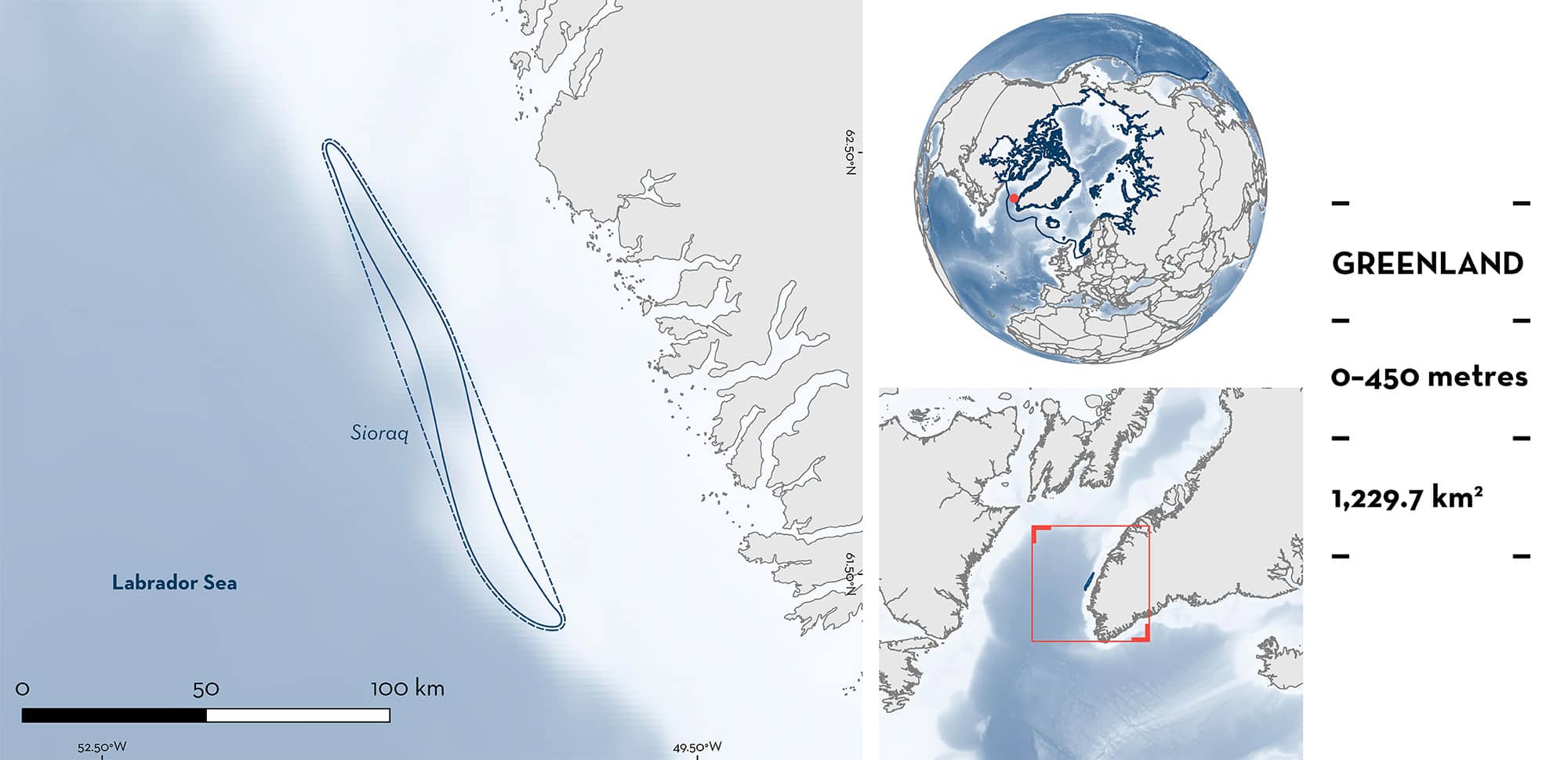ISRA FACTSHEETS
ISRA FACTSHEETS
POLAR WATERS REGION
Sioraq
Summary
Sioraq is located offshore on the continental shelf and slope of southwest Greenland. The area is influenced by Atlantic waters and the East Greenland Current. It is largely ice-free throughout the year. The area is characterised by both soft and hard benthic substrates. Within the area there are: threatened species and undefined aggregations (Greenland Shark Somniosus microcephalus).
Download factsheet
Sioraq
DESCRIPTION OF HABITAT
Sioraq is located offshore on the continental shelf and slope of southwest Greenland between the communities of Qeqertarsuatsiaat and Arsuk, named for its proximity to the Siroraq glacier that is visible from the area. It is characterised by soft and hard benthic substrates supporting diverse epibenthic communities across several banks and deepwater channels (Yesson et al. 2015).
The area is largely ice-free throughout the year due to the influx of warm Atlantic waters via the Irminger Current, which mixes in the region with cold Arctic surface waters from the East Greenland Current. Sioraq is highly productive and in boreal summer months supports high biodiversity (Boertmann et al. 2004).
This Important Shark and Ray Area is pelagic and is delineated from surface waters (0 m) to 450 m based on the depth range of Qualifying Species in the area.
CRITERION A
VULNERABILITY
One Qualifying Species within the area is considered threatened with extinction according to the IUCN Red List of Threatened Species. The Greenland Shark is assessed as Vulnerable (Kulka et al. 2020).
CRITERION C
SUB-CRITERION C5 – UNDEFINED AGGREGATIONS
Sioraq is an important area for undefined aggregations of one shark species.
Between 1988–2022, 106 Greenland Sharks were caught from 9,744 benthic trawl hauls in Greenland waters between 59.5°N and 74.6°N off the west coast, and between 59.5°N and 67.6°N off the east coast (Nielsen et al. 2020). Trawling occurred between 26–1,497 m, and animals were captured between 114–1,248 m. Greenland Sharks were more frequently caught in southwest Greenland (average of 13.8 sharks per 1,000 hauls) compared to east and northwest Greenland (11.6 and 7.4 sharks per 1,000 hauls, respectively). During this time period, most sharks were captured in southwest Greenland (n = 39 mature females). These animals were captured near the continental shelf break at 132–450 m depth and measured 420–474 cm total length (TL) (Nielsen et al. 2014, 2020).
Sioraq has one of the highest known densities of Greenland Shark catches within Greenland and is particularly important for aggregations of adults. Since 2009, ~90 trawl hauls per year have been surveyed in southwest Greenland (Nielsen et al. 2020). Within this area, the most regular and highest known density of contemporary Greenland Shark records in Greenland is reported (n = 21) with animals captured in 2009 (n = 1), 2010 (n = 3), 2012 (n = 2), 2014 (n = 2), 2015 (n = 1), 2016 (n = 2), 2017 (n = 4), 2020 (n = 3), and 2022 (n = 3). Most were caught in July (n = 18), with the others caught in June (n = 1) and September (n = 2). Greenland Sharks are thought to aggregate in Sioraq with two animals being captured in the same haul four times between 2016–2020 (n = 1 instances in 2016; n = 2 in 2017; and n = 1 in 2020). Furthermore, data from tagged animals indicates that they move into this area to aggregate across several months after having been tagged hundreds of kilometres away in southwest Greenland (Nielsen 2017).
The aggregation of Greenland Sharks in this area could be for reproductive purposes. The observation of adult females with hundreds of ripe ova in this area has not been documented elsewhere (J Nielsen pers. obs. 2024). Sexually mature females are caught in higher numbers in this area compared to other parts of Greenland (Nielsen et al. 2014) and across the Arctic (Nielsen et al. pers. obs. 2024). Half of the individuals studied in this area reached maturity at 418 cm TL (Nielsen et al. pers. obs. 2024). As the main survey was undertaken in July, additional temporal data are required to confirm seasonality of potential reproductive activities for Greenland Sharks in this area. The aggregation of Greenland Sharks in this area could also be for feeding purposes. Tagging studies of Greenland Sharks in Canada indicate this species can show high site fidelity in areas with high productivity which have been linked to potential foraging grounds (Edwards et al. 2022). Chlorophyll-a concentrations also peak in southwest Greenland in the boreal summer (Arrigo et al. 2017). Further information is required to determine the nature and function of these aggregations.
Download factsheet
SUBMIT A REQUEST
ISRA SPATIAL LAYER REQUEST
To make a request to download the ISRA Layer in either a GIS compatible Shapefile (.shp) or Google Earth compatible Keyhole Markup Language Zipped file (.kmz) please complete the following form. We will review your request and send the download details to you. We will endeavor to send you the requested files as soon as we can. However, please note that this is not an automated process, and before requests are responded to, they undergo internal review and authorization. As such, requests normally take 5–10 working days to process.
Should you have questions about the data or process, please do not hesitate to contact us.


